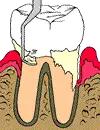
Periodontist
Bleeding Gums
Healthy gums do not bleed!
Bleeding gums are a sign of gingivitis or an infection. Healthy gums do not bleed. Brush and floss the area well. If bleeding persists, contact your dentist immediately for an appointment. Infection can lead to Gum Disease and tooth loss. Early stages of Gum Disease are rarely painful, so bleeding gums may be your only indication of Gum Disease!
So what’s the moral here? Healthy gums do not bleed!
Our Periodontist is specially trained in the treatment of:
- Advanced periodontal disease
- Cosmetic periodontal surgery
- Gingival grafting
- Placement of dental implants
Gum Disease
What is Gum Disease?
According to the American Dental Association, at least 60% of adults in the United States have moderate-to-severe gum disease! No doubt, you’ve heard some of the terms: Plaque, Tartar, Calculus, Gingivitis, Periodontitis, Pyorrhea, Periodontal Disease, Gum Disease. But what does it all mean? Quite simply, Gum Disease (Periodontal Disease) starts when plaque and tartar (calculus) are allowed to accumulate at the base of your teeth. The bacteria in the plaque leads to an infection in the gums (gingiva) called Gingivitis.
Left untreated, the infection spreads to the tissue and bone that holds your teeth in place, a condition called Periodontitis (Pyorrhea). Because of the bacterial infection associated with Periodontitis, tooth abscesses are also common.
What are the Signs of Gum Disease?
Gum Disease is rarely painful, especially in the early stages. Although there may be no visible signs, some of the common indications of Gum Disease are:
- Gums that bleed when you brush or floss (healthy gums will not bleed)
- Gums that are red, swollen, or tender
- Gums that have pulled away from the teeth (receded)
- Pus (infection) between the teeth and gums
- Loose permanent teeth or separating (drifting) teeth
- Changes in the way your teeth fit together when chewing
- Persistent bad breath
Do you need an appointment or simply have a question?
Call now (514) 694-8150 or fill out our contact form.
Gum Surgery
Sometimes, in order to treat advanced gum disease, surgical procedures are necessary, such as:
- Crown Lengthening
- Pocket Depth Reduction
- Soft Tissue Grafts
- Bone and Tissue Regeneration
- Ridge Augmentation
Advanced Medications
Recent advances in periodontal treatment allow us to now place medications directly at the site of infection. This is often used in conjunction with scaling and root planing. In addition, an antimicrobial rinse is sometimes used after some procedures.
Strict Home Care Regimen
A home care routine specific to the patient’s individual needs may be prepared to prevent the patient from relapsing.
For more information, please visit the CDA Website
Gum Treatment / Scaling / Root Planing
Gum treatment is the treatment of active gum and jaw bone disease. The treatment can slow or stop the progression of the disease. Since there are different stages of gum disease (from gingivitis to advanced periodontitis), there are different levels of treatment. In some cases, the patient may be referred to a specialist.
Gum treatment consists of one or more of the following procedures, depending on the individual case:
Scaling and Root Planing

Scaling and Root Planing is a common non-surgical treatment for periodontal disease. By using special instruments, we remove bacteria and infection from the unhealthy deep pockets around the teeth below the gum line. This is often referred to as a “deep cleaning”.

First the tooth is scaled to remove the plaque and tarter that has accumulated on the tooth.

Then the root is planed or smoothed. This eliminates any rough areas on the root that can easily trap plaque and bacteria.


